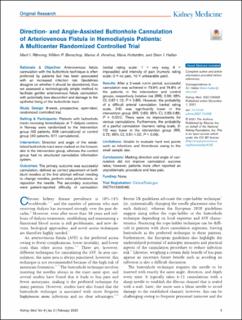| dc.description.abstract | Rationale & objective: Arteriovenous fistula cannulation with the buttonhole technique is often preferred by patients but has been associated with an increased infection risk. Guidelines disagree on whether it should be abandoned, thus we assessed a technologically simple method to facilitate gentler arteriovenous fistula cannulation with potentially less discomfort and damage to the epithelial lining of the buttonhole tract. Study design: 8-week, prospective, open-label, randomized controlled trial. Setting & participants: Patients with buttonhole tracts receiving hemodialysis at 7 dialysis centers in Norway were randomized to the intervention group (43 patients, 658 cannulations) or control group (40 patients, 611 cannulations). Intervention: Direction and angle of the established buttonhole tract were marked on the forearm skin in the intervention group, whereas the control group had no structured cannulation information system. Outcomes: The primary outcome was successful cannulation, defined as correct placement of both blunt needles at the first attempt without needing to change needles, perform extra perforations, or reposition the needle. The secondary outcomes were patient-reported difficulty of cannulation (verbal rating scale: 1 = very easy, 6 = impossible) and intensity of pain (numeric rating scale: 0 = no pain, 10 = unbearable pain). Results: After a 2-week run-in period, successful cannulation was achieved in 73.9% and 74.8% of the patients in the intervention and control groups, respectively (relative risk [RR], 0.99; 95% CI, 0.87-1.12; P = 0.85). However, the probability of a difficult arterial cannulation (verbal rating scale, 3-6) was significantly lower in the intervention group (RR, 0.69; 95% CI, 0.55-0.85; P = 0.001). There were no improvements for venous cannulations. Furthermore, the probability of a painful cannulation (numeric rating scale, 3-10) was lower in the intervention group (RR, 0.72; 95% CI, 0.51-1.02; P = 0.06). Limitations: Unable to evaluate hard end points such as infections and thrombosis owing to the small sample size. Conclusions: Marking direction and angle of cannulation did not improve cannulation success rates; however, patients more often reported an unproblematic procedure and less pain. Funding: None. Trial registration: ClinicalTrials.gov (NCT01536548). | en_US |

